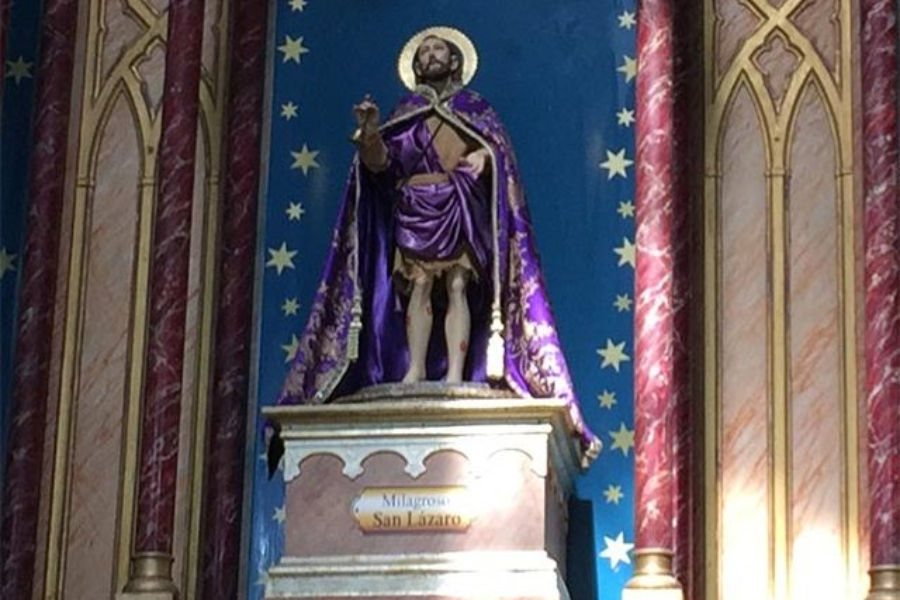The Legacy of St Lazarus Abba Kwi: How This Cuban Icon Represents Healing and Resilience
St. Lazarus: A Fusion of Faith and Tradition in Cuban Culture
st lazarus abba kwi cuban is a notable figure in both Christian and Afro-Cuban traditions, embodying rich layers of spiritual significance.
Biblical Background
st lazarus abba kwi cuban known from the Bible in two distinct roles:
- Lazarus of Bethany: Featured in the Gospel of John, this Lazarus is renowned for being resurrected by Jesus after having been dead for four days. This miracle highlights themes of faith and divine power.
- The Poor Beggar Lazarus: In the Gospel of Luke, Lazarus is a destitute man who suffers in life but finds comfort in the afterlife, contrasting with a rich man who neglected him.
Cuban Traditions and Syncretism
In Cuba, st lazarus abba kwi cuban transcends his biblical origins to become a central figure in Santería, a syncretic religion merging Catholicism with Yoruba traditions. Here, he is often identified with Babalu Aye, an orisha in Yoruba belief linked to illness, healing, and compassion.
Iconography and Worship
In Cuban Santería,st lazarus abba kwi cuban , or Abba Kwi, is depicted as a frail figure in rags, supported by crutches and often accompanied by dogs. This portrayal emphasizes suffering and healing, reflecting his dual role as both a Christian saint and a Yoruba orisha.
Understanding Abba Kwi
“Abba Kwi” is a term used in certain Cuban spiritual contexts, combining reverence with specific cultural meanings. While its exact interpretation may vary, it generally signifies a respectful title within the syncretic practices that st lazarus abba kwi cuban.
The Role of St. Lazarus Abba Kwi in Cuban Culture: Faith, Resilience, and Rituals
A Beacon of Faith and Resilience
In Cuban culture,st lazarus abba kwi cuban stands as a powerful symbol of faith and resilience. More than just a religious figure, he embodies the enduring spirit of the Cuban people. His image as a figure enduring suffering while offering healing resonates deeply with those who have faced hardship. Particularly revered by marginalized communities, st lazarus abba kwi serves as a beacon of hope and perseverance.
The Annual Pilgrimage to El Rincón
One of the most important religious events in Cuba is the pilgrimage to El Rincón, a village near Havana, held on December 17th. This annual event draws thousands of devotees from across Cuba and beyond, making it a significant expression of faith and devotion. Pilgrims engage in various acts of reverence, including:
- Crawling for Miles: Some devotees crawl on their hands and knees as an act of fulfillment of promises or to seek favor.
- Carrying Crosses: Heavy crosses are carried as a form of penitence.
- Lighting Candles and Offering Flowers: At the shrine, pilgrims light candles and lay flowers as symbols of their devotion.
This pilgrimage uniquely blends Christian and Afro-Cuban elements, reflecting the rich tapestry of Cuba’s religious identity.
Daily Devotional Practices
Many Cubans maintain a personal connection with st lazarus abba kwi Abba Kwi through daily or weekly rituals at home altars. Common practices include:
- Candles: Lit to seek blessings or healing.
- Flowers and Herbs: Used to show reverence.
- Food Offerings: Items like roasted pork or fruits are offered, tying in with traditional Cuban cuisine.
- Dog Statues: Small statues of dogs represent the animals said to have licked Lazarus’s wounds, symbolizing compassion and loyalty.
These rituals highlight how st lazarus abba kwi Abba Kwi is seen as an accessible and responsive figure, deeply integrated into the daily lives of his devotees.
st lazarus abba kwi and Santería: A Spiritual Fusion
Babalu Aye’s Role
In Santería, a syncretic religion that combines African Yoruba beliefs with Catholicism,st lazarus abba kwi is often identified with Babalu Aye, an orisha associated with illness and healing. The integration of st lazarus abba kwi with Babalu Aye exemplifies how Afro-Cuban religious practices blend African spiritual traditions with Catholic symbolism.
Rituals and Offerings
Practitioners of Santería perform specific rituals for Babalu Aye, which may include:
- Sacrifices of Small Animals: Traditional offerings to Babalu Aye.
- Herbal Baths: Used for spiritual cleansing, invoking the healing powers of both Babalu Aye and St. Lazarus.
- Dance Ceremonies: Energetic drumming and dancing are integral to rituals, reflecting the vibrant African influence within Santería.
The Healing Power of St lazarus abba kwi: Faith, Miracles, and Cultural Harmony
Seeking Healing and Protection
For many devotees, st lazarus abba kwi Abba Kwi is a vital source of healing and solace. Belief in his ability to cure both physical and emotional afflictions is deeply ingrained. People often carry medallions or wear images of st lazarus abba kwi as protective charms, hoping to ward off illness and invite his healing presence into their lives.
Stories of Miracles
The faith in st lazarus abba kwi healing powers is bolstered by countless personal stories of miracles. These accounts, passed down through generations, contribute to the saint’s enduring mystique. For many Cubans, these testimonies affirm that st lazarus abba kwi is always attentive and ready to offer help in times of need.
Cultural and Spiritual Fusion
Cuba’s rich cultural tapestry is reflected in its religious practices, exemplified by the veneration of st lazarus abba kwi. This figure represents a unique fusion of:
- Christian and African Spirituality: The blending of Catholicism and Yoruba traditions creates a distinct religious identity.
- Syncretism: The overlap of Catholic and Santería rituals allows for a harmonious coexistence of different faiths.
- Evolving Traditions: As new generations reinterpret and blend religious practices, they continue to enrich Cuba’s spiritual landscape.
This cultural synthesis showcases how diverse spiritual traditions can coexist and evolve together, creating a vibrant and inclusive religious experience.
Ways to Honorst lazarus abba kwi
If you wish to pay homage to st lazarus abba kwi , here are some meaningful ways to do so:
- Set Up an Altar: Create a dedicated space in your home for a statue or image of st lazarus abba kwi, and adorn it with candles, flowers, and offerings.
- Light a Candle: On Wednesdays, a day traditionally associated with st lazarus abba kwi, light a candle to seek his protection and blessings.
- Offer Prayers: Recite prayers asking for healing, guidance, or support during challenging times.
- Participate in Pilgrimages: If possible, take part in the annual pilgrimage to El Rincón in Cuba to connect with the saint’s legacy and experience the communal aspects of devotion.
Global Impact
The influence of st lazarus abba kwi extends beyond Cuba, reaching Cuban communities worldwide. As these communities grow and spread, they bring the veneration of st lazarus abba kwi to new cultures, continuing the tradition of this unique spiritual fusion.
FAQs:
1. Who is st lazarus abba kwi?
st lazarus abba kwi is a revered figure in Cuban culture, blending elements of the Christianst lazarus abba kwi and the Yoruba orisha Babalu Aye. He symbolizes healing, compassion, and resilience, and is honored in both Catholic and Afro-Cuban religious practices.
2. What is the significance of St. Lazarus Abba Kwi in Cuban religious life?
In Cuban religious life,st lazarus abba kwi represents the enduring spirit of the people, especially those who are marginalized. His veneration reflects themes of hope, healing, and compassion, making him a symbol of strength for many.
3. What is the annual pilgrimage to El Rincón?
The annual pilgrimage to El Rincón, held on December 17th, is a major event where thousands of devotees gather to pay homage to St. Lazarus Abba Kwi. Pilgrims perform acts of devotion such as crawling on their knees, carrying crosses, and making offerings at the shrine.
4. How do devotees honor St. Lazarus Abba Kwi at home?
Devotees often create home altars dedicated to St. Lazarus, where they light candles, offer flowers and food, and keep small dog statues as symbols of compassion. Lighting candles on Wednesdays and reciting prayers are also common practices.
5. How is St. Lazarus Abba Kwi connected to Santería?
In Santería, St. Lazarus is syncretized with Babalu Aye, an orisha associated with disease and healing. The blending of St. Lazarus and Babalu Aye represents the fusion of Catholic and African spiritual traditions in Cuban religious practices.
6. What role do miracles play in the veneration of St. Lazarus Abba Kwi?
Miracles and personal testimonies of healing are central to the veneration of St. Lazarus Abba Kwi. Many devotees share stories of miraculous recoveries and divine intervention, reinforcing their faith in his power and presence.
Conclusion
St. Lazarus Abba Kwi holds a profound place in Cuban culture, embodying a rich blend of Christian and Afro-Cuban spiritual traditions. His role as a symbol of healing, resilience, and compassion resonates deeply with those who revere him. The annual pilgrimage to El Rincón and the daily rituals performed in his honor showcase the enduring faith and devotion of his followers. As both a religious figure and a cultural icon, St. Lazarus Abba Kwi continues to inspire and provide solace to countless individuals, bridging diverse spiritual practices and traditions in a uniquely Cuban way.
Explore intriguing articles and the newest trends in entertainment at Tamasha.blog.






